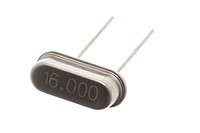
Back مذبذب بلوري Arabic Oscil·lador de quars Catalan Quarzoszillator German Oscilador de cristal Spanish Kristallostsillaator Estonian نوسانساز کریستالی Persian Kide (komponentti) Finnish Quartz (électronique) French מתנד גבישי HE Kvarcni oscilator Croatian
 A miniature 16 MHz quartz crystal enclosed in a hermetically sealed HC-49/S package, used as the resonator in a crystal oscillator. | |
| Type | Electromechanical |
|---|---|
| Working principle | Piezoelectricity, Resonance |
| Invented | Alexander M. Nicholson, Walter Guyton Cady |
| First production | 1918 |
| Electronic symbol | |
 | |
A crystal oscillator is an electronic oscillator circuit that uses a piezoelectric crystal as a frequency-selective element.[1][2][3] The oscillator frequency is often used to keep track of time, as in quartz wristwatches, to provide a stable clock signal for digital integrated circuits, and to stabilize frequencies for radio transmitters and receivers. The most common type of piezoelectric resonator used is a quartz crystal, so oscillator circuits incorporating them became known as crystal oscillators.[1] However, other piezoelectric materials including polycrystalline ceramics are used in similar circuits.
A crystal oscillator relies on the slight change in shape of a quartz crystal under an electric field, a property known as inverse piezoelectricity. A voltage applied to the electrodes on the crystal causes it to change shape; when the voltage is removed, the crystal generates a small voltage as it elastically returns to its original shape. The quartz oscillates at a stable resonant frequency, behaving like an RLC circuit, but with a much higher Q factor (less energy loss on each cycle of oscillation). Once a quartz crystal is adjusted to a particular frequency (which is affected by the mass of electrodes attached to the crystal, the orientation of the crystal, temperature and other factors), it maintains that frequency with high stability.[4]
Quartz crystals are manufactured for frequencies from a few tens of kilohertz to hundreds of megahertz. As of 2003, around two billion crystals were manufactured annually.[5] Most are used for consumer devices such as wristwatches, clocks, radios, computers, and cellphones. However, in applications where small size and weight is needed crystals can be replaced by thin-film bulk acoustic resonators, specifically if ultra-high frequency (more than roughly 1.5 GHz) resonance is needed. Quartz crystals are also found inside test and measurement equipment, such as counters, signal generators, and oscilloscopes.
- ^ a b Graf, Rudolf F. (1999). Modern Dictionary of Electronics, 7th Ed. US: Newnes. pp. 162, 163. ISBN 978-0750698665.
- ^ Amos, S. W.; Roger Amos (2002). Newnes Dictionary of Electronics, 4th Ed. US: Newnes. p. 76. ISBN 978-0750656429.
- ^ Laplante, Phillip A. (1999). Comprehensive Dictionary of Electrical Engineering. US: Springer. ISBN 978-3540648352.
- ^ Paul Horowitz, Winfield Hill, The Art of Electronics Second Edition, Cambridge University Press, 1989, ISBN 0-521-37095-7, pg. 300 ff
- ^ Lombardi, Michael (2003). Encyclopedia of Physical Science and Technology (3rd ed.).